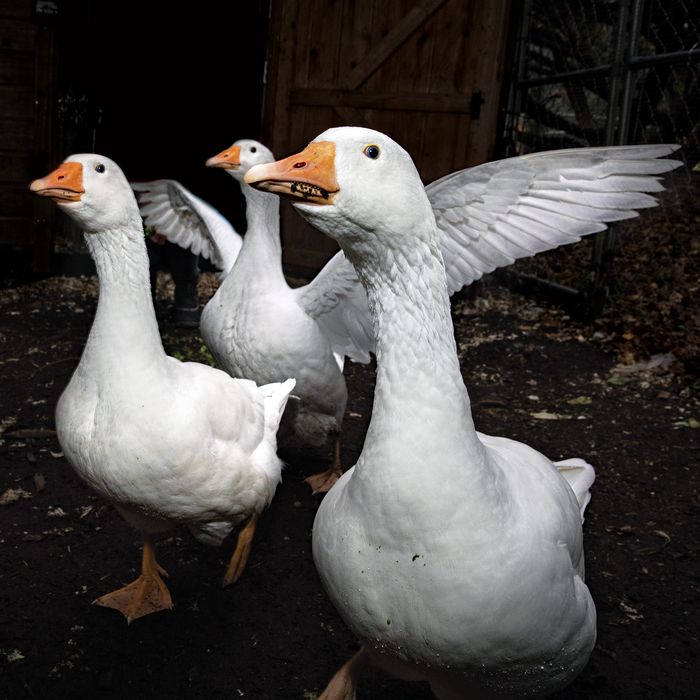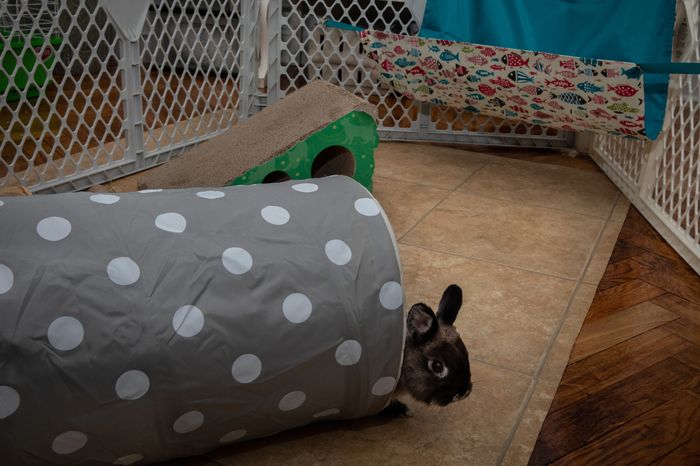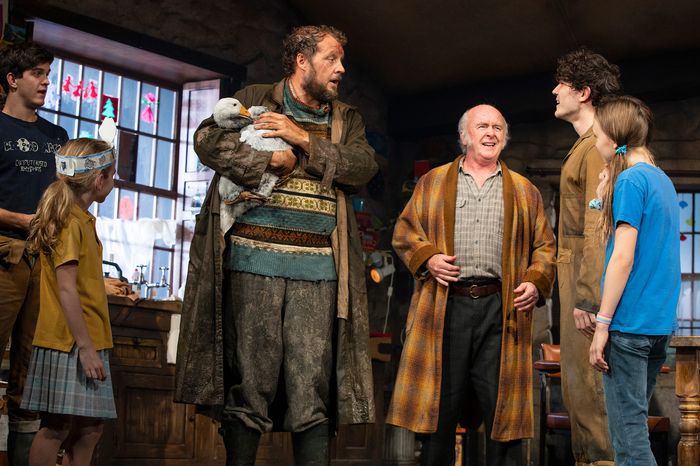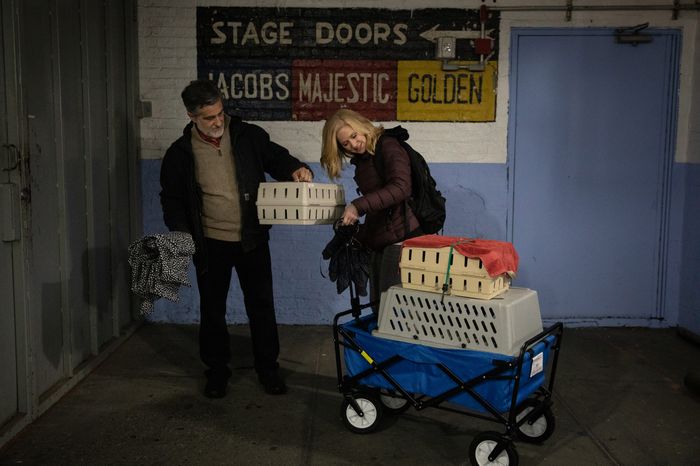
Among a cast of dozens playing an extended Northern Irish family, including aunts, uncles, cousins, and even babies, the breakout stars of The Ferryman may well be the animal actors. Jez Butterworth’s play is set in a 1980s farmhouse on the eve of a harvest, and the characters freely interact with the livestock, including a live bunny, a Netherland Dwarf rabbit named Pierce, and, in a brief-but-striking moment, an Emden goose named Peggy.
Though the animals are onstage for mere minutes of the show’s three-hour-plus running time, they — plus two understudies each — require their own quarters backstage, months of conditioning, and an intense daily schedule to prepare them for each of their eight shows a week. That’s all managed by animal trainer Bill Berloni and handler Rochelle Scudder, who have worked together on several productions before, but never with animals like these. “There’s not a lot of precedent with waterfowl in a theater,” Scudder said.
Months before The Ferryman began rehearsals in September in New York, Berloni and his company began casting the animals. Because the British production already had props and costumes designed around the animals used in London, they needed to find geese and rabbits of the right breed and size to match.
Berloni’s wife, Dorothy, who also works on the team, found the last available clutch of goslings of the correct breed, while Pierce the rabbit came from Chicago, with the others sourced from other parts of America. The goslings arrived in late June, while the rabbits arrived a few weeks later. “We really had to network to find the right size, the right color,” Berloni said.
You can’t train geese or rabbits in the way that you might a dog, but the animals had to learn to become comfortable with the conditions of performing onstage. “It was a lot of, ‘Let’s carry the baby geese around,’ and pet them and touch them and get them used to it,” Berloni said. “The same thing with bunnies. We got very young bunnies, three to six months old, and started handling them a lot.”
Toward the end of the initial training, the trainers did an “internal casting call” and selected three geese and three bunnies that seemed best suited for life as a performer. Of the bunnies, Pierce, the calmest, became the star. His understudy Willis, the second calmest, is currently in training, while the other rabbit Harrison “outgrew the role before he ever saw the stage.” For the geese, the trainers decided on Peggy, the smallest. “She was a follower,” Scudder said. “So when we took her away from those other two, she was more inclined to follow me.”
Though Pierce and Peggy became the show’s stars, both they and their understudies needed places to live for the duration of the show’s runs. They went to stay with Scudder’s family in her apartment in Washington Heights, but the geese were harder to place. It’s illegal to keep waterfowl within New York City, so the trainers looked at stables and even private homes just outside the city limits in order to find somewhere that could house geese well and would be within a reasonable commute to the city. “There were four weeks of calling and visiting places and going, ‘Where the heck are we gonna put the geese?’” Berloni said, and they settled on a nature center in Scarsdale, where they eventually plan to do educational courses in the spring.
This far into the run, the animals have developed a daily routine. Early in the morning, Scudder refills the rabbits’ food and water and lets them out into their playpen one at a time, since they are all male and “can’t really play together.” Then she brings Pierce — with or without his understudy, depending on the day — to her car and drives to Scarsdale to pick up Peggy, and then drives back to the theater hours before the show begins to settle the animals in backstage.
There, Peggy, the rabbits, and Scudder have their own enclosure within the Bernard B. Jacobs Theatre. “These old theaters were not meant to house the productions that are coming in now,” Berloni said. “So finding a space in a theater, and saying, ‘We need 100 square feet of footage,’ it’s like negotiating your name above the title.” But the production listened, and the animals got their own piece of real estate in one of the most expensive parts of the city, complete with extra ventilation, which helps with any smells. “They built us this great space that may not be palatial, but it works,” Berloni said, “and there’s Wi-Fi and a coffee machine.”
Two actors handle the animals onstage, both of whom have prior experience with animals. Brooklyn Shuck, who plays the young Nunu Carney, briefly holds the rabbit and had worked with Berloni in the recent revival of Annie, and “she knew our technique, she knew how to be calm,” he said. Justin Edwards, who plays the kindly handyman Tom Kettle, handles both the rabbit, and in the key scene, the goose. He had both the experience of performing in the London cast with their animals, and a calm temperament. “The moment he met these animals, he just picked them up, and they just sat there,” Berloni remembered. “There was very little for us to do with the actor, and more to do with just bringing them backstage. We got very lucky.”
The animals have finished all their appearances onstage midway through the second act, but leave the theater during the short pause between acts two and three of The Ferryman. That’s to make sure the sound of Peggy honking as she leaves the theater doesn’t disrupt any of the play’s darker, quieter scenes, which happened during an early performance.
Luckily for their trainers, both Peggy and Pierce have adapted well to the stage, and Peggy has even learned a bit of comic timing. When Edwards brings her onstage, he delivers a line about wringing the goose’s neck, to which the audience tends to gasp or laugh. The goose has learned to expect that reaction, and now she’ll turn to anticipate it, “like she’s doing a take to the audience,” which gets her more applause, according to Berloni.
Even if the animals are performing well now, Berloni and Scudder closely monitor their behavior for signs that they might get spooked and need to stop performing, which could happen at any moment. “At that point,” Berloni said, “As humane animal trainers, you go, ‘You’re done. We’re not gonna push you out there.” They’ve started to train backup animals for this purpose.
Once the animals finish their runs onstage and the show closes, the geese will move to Berloni’s “retirement home for performing animals” on his farm in Connecticut, where he already has 30 dogs, cats, horses, a macaw, and a couple pigs. “The bunnies are more than welcome,” Berloni added, “but I have a feeling there are gonna be a lot of people who will want to adopt them.”
*A version of this article appears in the November 26, 2018, issue of New York Magazine. Subscribe Now!






